Waterwise
Even in years with plentiful winter rainfall, our summers in Santa Clara County will always be dry. Planning your landscaping and gardens for our summer dry conditions will put you ahead of the game for future droughts and water restrictions. Here are some useful tips and links for homeowners and gardeners who want to manage their garden and landscape in a responsible, waterwise manner.
Waterwise Tips
Ailing Ornamental TreesIf you have an ailing tree, here are some questions you can ask yourself to begin diagnosing the problem: is the entire canopy of the tree affected? If the answer is yes, you can reasonably guess that something is wrong below the soil. A lack of nutrients (refer to the UC Pest Note on Mineral Deficiencies) will likely cause the leaves to either die (necrosis) or lose color (chlorosis). Too much or too little water will also cause foliage problems (See UC Pest Note on Poor Water Management, Poor Drainage). If only parts of the tree are affected, it is likely your problem is above ground. Is there a pattern to the distress? You can rule out or suspect sunscald by determining which side of the tree faces the harshest sun (UC Pest Note on Sunburn). What kind of tree is it? Is there new growth? If there is, that’s a great sign that a single event rather than an ongoing problem distressed your tree. The UC IPM website will direct you to species-specific pests and disorders to begin diagnosing your tree's ailments. |
Aloe Plants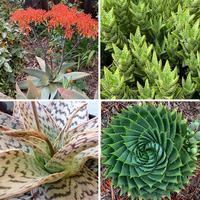
Clockwise from upper left: Aloe striata (coral aloe), Aloe juvenna (Tiger Tooth Aloe), Aloe polyphylla (spiral aloe), Aloe ‘Delta Lights’
You can see their dramatic stalks of flowers here. Photo: Aloe flowers, clockwise from upper left: Aloe ferox, Aloe striata (coral aloe), Aloe polyphylla (spiral aloe), Aloe ‘Rooikappie’ |
Arboretum All-Stars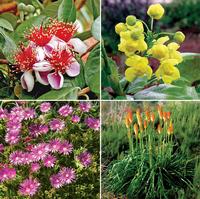
Clockwise from top left: pineapple guava, compact Oregon grape, Christmas cheer poker plant, Cooper’s ice plant, UC Davis Arboretum
More Information: UC Davis Arboretum All-Stars
|
Container Color ChoiceIf you are growing plants in containers, keep in mind that light colors do a better job at reflecting the sun. This helps keep the soil from drying out too quickly and reduces the chances of the roots burning. If you already have dark pots, consider painting them a lighter color, or be especially careful about watering. |
Drip Irrigation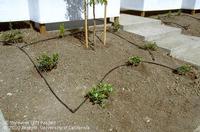
Low volume drip irrigation system
- Water is placed more accurately and efficiently in the root zone, it is applied at a slow rate that reduces loss from runoff. The key to success is watering long enough to supply adequate water to the root zone. Inappropriate watering commonly damages landscape plants. As with any irrigation system, they are efficient only when soil around the plants being irrigated is regularly monitored for proper moisture levels (Reference: UC Pest Note Poor Water Management, Poor Drainage). |
Drought or Disease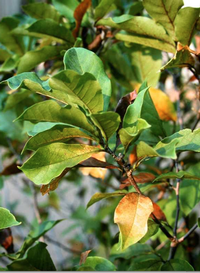
More Information: Drought or Disease |
Drought Tip - Laundry to Landscape IrrigationA laundry to landscape system is an easy way to save water in times of drought. It can be installed easily at a low cost to send rinse water from clothes washers directly to the landscape.
Suitable plants include fruit and ornamental trees, shrubs, and ornamental annuals. It’s not applicable where the water would come in direct contact with fruits or vegetables. More information: Laundry-to-Landscape Graywater System
|
Drought Tip - Lawns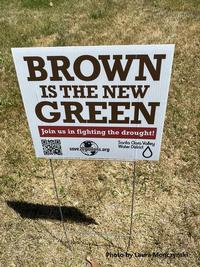
More information: Drought Resources |
Drought Tip - No Fertilizer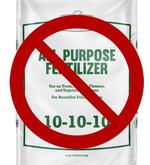
More information: Skip fertilizing |
Drought Tip - Trees Come First during Drought
More information: Tips to Keep Trees Alive
|
EcheveriaIt's easy to have color in your yard without using a lot of water. Instead of planting thirsty annuals, consider some of the many types of succulents. Echeveria does well in containers or in the ground. Plant them in well-drained soil and allow the soil to dry between waterings. They aren't particular about sun or shade, although some can be a little sensitive to full afternoon summer sun. |
Fall IrrigationYou can still expect some warm weather during October, so keep watering the garden until the fall and winter rains begin. As temperatures drop, less water is needed for plants. Check your soil periodically by digging gently into the soil next to the root, about 6 inches down (deeper for bigger plants). If the soil does not hold a shape when squeezed it is too dry; if it continues to hold shape after the pressure is released it is too wet; if the soil has a shape then crumbles quickly, it has the right amount of water. Hydrozone any new plantings by putting plants with similar water needs together. This helps ensure that less water is wasted and that all plants get the right amount of water. If you have an automatic watering system, this is a good time to inspect the system for leaks and blockages, check the timer for batteries, and reprogram the system as necessary for cooler weather and rain. If you don't have an automatic watering system, think about installing one. Many systems are very affordable and easy to install by the home gardener. Take a look at some "smart meters". They are more expensive, but incorporate weather conditions, your location, and your soil into the programming, making them very efficient. |
Fertilizing Ornamentals During DroughtOne way to manage plants during drought is to reduce the amount of fertilizer used. While plants need nutrients to survive and be healthy, excess fertilizer promotes additional growth, which then demands more water. |
Garden Planning in a Drought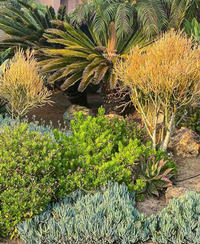
More information: Drought: Gardening Tips
|
Going NativeNative shrubs, trees, and flowers are well-adapted to our climate and soil, and support native butterflies and bees and other wildlife. They are drought-tolerant once they are established, but need adequate water for the first year or two to establish a strong root system that will help nourish the plant for years to come. Planting them in the fall gives them time to settle in before being hit by the heat of the summer sun. Consult Water Wise Plants and the California Native Plant Society for more information. |
Lawn AlternativesDo you have a traditional lawn? Would you like something that doesn’t need regular mowing? Something that uses less water? If you’re not ready to completely remove your lawn, walkable alternatives include California native options of red fescue and meadow sedge, as well as other alternatives like white clover, UC Verde buffalograss, Kurapia, Dymondia, and thyme.
For more information: Lawn & Lawn Alternatives |
Lawn Care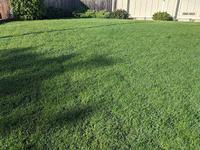
Make sure you are mowing to a height appropriate for your type of grass. Mow frequently enough so that only one-third of the leaf is removed at any one time. Fertilizing is important, even if you are grasscycling, which only provides about 20% of a lawn's fertilizer needs. Grass is all leaf so the primary nutrient needed is nitrogen. Keep on top of weed removal. Thatch is the layer of living and dead grass material (blades, rhizomes, stolons) that can build up on the surface of the lawn. A thin layer protects the soil surface and shallow roots from drying out from the sun, but a thick layer prevents water from getting through. You can remove dead grass material on the soil surface with a special thatch rake to allows water to reach the roots more easily. More Information: The UC Guide to Healthy Lawns |
Save Water and Make Your Plants HappierAfter your vegetable garden is well established, it's better to water thoroughly once a week rather than giving it a light watering every day. Doing that will encourage a deeper root system which will help the plants tolerate dry weather better. This is also true for fruit trees. For more information visit UC Pest Note on Watering Fruit and Nut Tress. |
Tomato blossom end rot
|
Water BudgetingWe always need to use water wisely. Sometimes it is necessary to stop and think about your landscape and prioritize water use. Trees are a long-term investment, yet mature trees may have extensive root systems enabling them to find enough water on their own. Fruit trees may need watering approximately monthly during the summer in order to produce good fruit. Vegetables should always be given adequate water in order to fulfill their purpose in the garden; otherwise the little bit of water you used will have been wasted if the garden is not feeding you well. It’s helpful to understand that home-grown vegetables use much less water overall than ones purchased at the store. Established flowering shrubs, especially California natives, tend to need less water than annual flowers and maybe a more water-efficient way to have color and beauty in your garden. Lastly, keep the weeds under control so that they don’t rob water from the plants that you actually want.
More Information: Water Use Classification of Landscape Species (WUCOLS)
|
Water the Roots, Not the PlantsIt's tempting to get the hose out and spray your dry, thirsty plants, but you don't want to waste water. Keep their feet nice and cool, but resist the urge to squirt the leaves unless they need a cleaning (for dust or white fly for instance). It's a common belief that daytime water on the leaves will burn them. While it's possible, according to scientists—for hairy leafed plants where water droplets are held above the leaf surface—but not very likely. It's more the water will simply evaporate and not do your plants much good and could encourage fungal pathogens if wet overnight. |
Watering Hydrophobic SoilJust as a dry sponge repels water, overly dry soil can do the same thing. This dried out soil is called hydrophobic. Hydrophobic soil can waste a lot of water as water drains away from the plant's root zone. In pots: learn more about how to re-wet very dry soil on our Watering Hydrophobic Soil page. In the yard: setting sprinklers to run for 5 minutes, waiting for the water to soak in, and then running for a longer time can prevent water loss due to hydrophobic soil. |







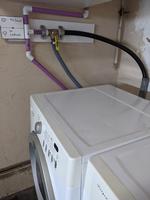
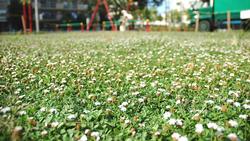
 A brown depression on the bottom of tomatoes is usually blossom end rot (BER). This disorder is related to a calcium deficiency aggravated by irregular watering. Since most soils have adequate calcium, watering is usually the problem. Without regular watering, the calcium in the soil cannot reach the plant. Mulching can help. Water tomatoes regularly. Avoid flooding them so the roots sit in water. For more detailed information about BER please view
A brown depression on the bottom of tomatoes is usually blossom end rot (BER). This disorder is related to a calcium deficiency aggravated by irregular watering. Since most soils have adequate calcium, watering is usually the problem. Without regular watering, the calcium in the soil cannot reach the plant. Mulching can help. Water tomatoes regularly. Avoid flooding them so the roots sit in water. For more detailed information about BER please view